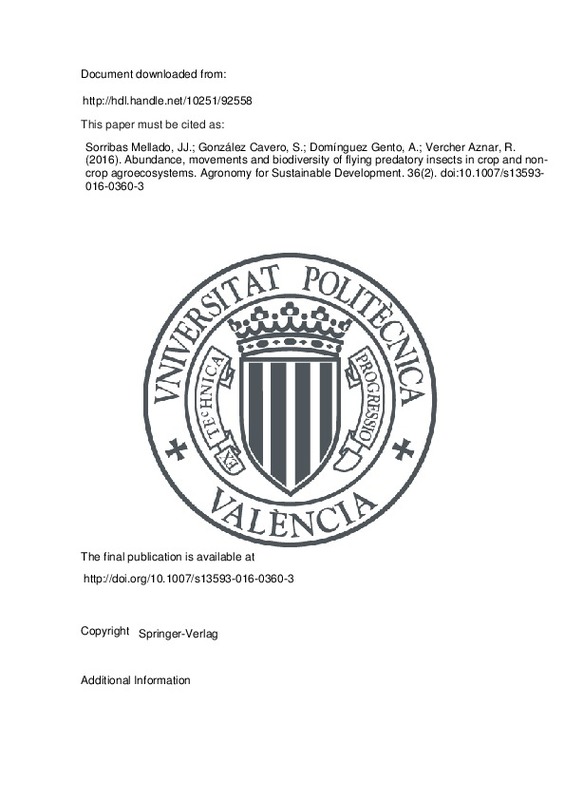Altieri MA, Letourneau DK (1982) Vegetation management and biological control in agroecosystems. Crop Prot 1:405–430. doi: 10.1016/0261-2194(82)90023-0
Altieri MA, Schmidt LL (1986) The dynamics of colonizing arthropod communities at the interface of abandoned, organic and commercial apple orchards and adjacent woodland habitats. Agric Ecosyst Environ 16:29–43. doi: 10.1016/0167-8809(86)90073-3
Bengtsson J, Ahnström J, Weibull A (2005) The effects of organic agriculture on biodiversity and abundance: a meta-analysis. J App Ecol 42:261–269. doi: 10.1111/j.1365-2664.2005.01005.x
[+]
Altieri MA, Letourneau DK (1982) Vegetation management and biological control in agroecosystems. Crop Prot 1:405–430. doi: 10.1016/0261-2194(82)90023-0
Altieri MA, Schmidt LL (1986) The dynamics of colonizing arthropod communities at the interface of abandoned, organic and commercial apple orchards and adjacent woodland habitats. Agric Ecosyst Environ 16:29–43. doi: 10.1016/0167-8809(86)90073-3
Bengtsson J, Ahnström J, Weibull A (2005) The effects of organic agriculture on biodiversity and abundance: a meta-analysis. J App Ecol 42:261–269. doi: 10.1111/j.1365-2664.2005.01005.x
Bianchi F, Booij CJH, Tscharntke T (2006) Sustainable pest regulation in agricultural landscapes: a review on landscape composition, biodiversity and natural pest control. Proc R Soc B 273:1715–1727. doi: 10.1098/rspb.2006.3530
Chaplin-Kramer RM, Rourke E, Blitzer EJ, Kremen C (2011) A meta-analysis of crop pest and natural enemy response to landscape complexity. Ecol Lett 14:922–932. doi: 10.1111/j.1461-0248.2011.01642.x
Crowder DW, Northfield TD, Strand MR, Snyder WE (2010) Organic agriculture promotes evenness and natural pest control. Nature 466:109–112. doi: 10.1038/nature09183
Dogramaci M, DeBano SJ, Kimoto C, Wooster DE (2011) A backpack-mounted suction apparatus for collecting arthropods from various habitats and vegetation. Entomol Exp et Appl 139:86–90. doi: 10.1111/j.1570-7458.2011.01099.x
Duelli P, Studer M, Marchland I, Jakob S (1990) Population movements of arthropods between natural and cultivated areas. Biol Conserv 54:193–207. doi: 10.1016/0006-3207(90)90051-P
Eilenberg J, Hajek A, Lomer C (2001) Suggestions for unifying the terminology in biological control. BioControl 46:387–400. doi: 10.1023/A:1014193329979
Forman RTT, Baudry J (1984) Hedgerows and hedgerow networks in landscape ecology. Environ Manage 8:495–510. doi: 10.1007/BF01871575
Gurr GM, Wratten SD, Luna JM (2003) Multi-function agricultural biodiversity: pest management and other benefits. Basic Appl Ecol 4:107–116. doi: 10.1078/1439-1791-00122
Hole DG, Perkins AJ et al (2005) Does organic farming benefit biodiversity? Biol Conserv 122:113–130. doi: 10.1016/j.biocon.2004.07.018
Landis DA, Wratten SD, Gurr GM (2000) Habitat management to conserve natural enemies of arthropod pests in agriculture. Annu Rev Entomol 45:175–201. doi: 10.1146/annurev.ento.45.1.175
Long RF, Corbett A, Lamb C, Reberg-Horton C, Chandler J, Stimmann M (1998) Beneficial insects move from flowering plants to nearby crops. Calif Agr 52:23–26. doi: 10.3733/ca.v052n05p23
Östman Ö, Ekbom B, Bengtsson J (2001) Landscape heterogeneity and farming practice influence biological control. Basic App Ecol 2:365–371. doi: 10.1078/1439-1791-00072
Pantaleoni RA, Ticchiati V (1988) I Neurotteri delle colture agrarie: osservazioni sulle fluttuazioni stagionali di populazione in frutteti. Boll dell’Ist di Entomol 43:43–57
Panzer R, Schwartz MW (1998) Effectiveness of a vegetation-based approach to insect conservation. Conserv Biol 12:693–702. doi: 10.1111/j.1523-1739.1998.97051.x
Paredes D, Cayuela L, Gurr G, Campos M (2013) Effect of non-crop vegetation types on conservation biological control of pests in olive groves. PeerJ 1:1–16. doi: 10.7717/peerj.116
Pekar S, Michalko R, Loverre P, Líznarová E, Cernecká L (2015) Biological control in winter: novel evidence for the importance of generalist predators. J Appl Ecol 52:270–279. doi: 10.1111/1365-2664.12363
Pollard KA, Holland JM (2006) Arthropods within the woody element of hedgerows and their distribution pattern. Agric Forest Entomol 8:203–211. doi: 10.1111/j.1461-9563.2006.00297.x
Rand TA, Tylianakis JM, Tscharntke T (2006) Spillover edge effects: the dispersal of agriculturally subsidized insect natural enemies into adjacent natural habitats. Ecol Lett 9:603–614. doi: 10.1111/j.1461-0248.2006.00911.x
Silva EB, Franco JC, Vasconcelos T, Branco M (2010) Effect of ground cover vegetation on the abundance and diversity of beneficial arthropods in citrus orchards. Bull Entomol Res 100:489–499. doi: 10.1017/S0007485309990526
Smukler SM, Sánchez-Moreno S et al (2010) Biodiversity and multiple ecosystem functions in an organic farmscape. Agric Ecosyst Environ 139:80–97. doi: 10.1016/j.agee.2010.07.004
Stelzl M, Devetak D (1999) Neuroptera in agricultural ecosystems. Agric Ecosyst Environ 74:305–321. doi: 10.1016/S0167-8809(99)00040-7
Straub CS, Finke DL, Snyder WE (2008) Are the conservation of natural enemy biodiversity and biological control compatible goals? Biol Control 45:225–237. doi: 10.1016/j.biocontrol.2007.05.013
Thierry D, Deutsch B, Paulian M, Villenave J, Canard M (2005) Typifying ecosystems by using green lacewing assemblages. Agron Sustain Dev 25:473–479. doi: 10.1051/agro:2005047
Thomas CFG, Parkinson L, Griffiths GJK, García AF, Marshall EJP (2001) Aggregation and temporal stability of carabid beetle distributions in field and hedgerow habitats. J App Ecol 38:100–116. doi: 10.1046/j.1365-2664.2001.00574.x
Villenave J, Thierry D, Mamun A, Lode T, Rat-Morris E (2005) The pollens consumed by common green lacewings Chrysoperla spp. in cabbage crop environment in western France. Eur J Entomol 02:547–552, 10.14411/eje.2005.078
You M, Hou Y, Liu Y, Yang G, Li Z, Cai H (2004) Non-crop habitat manipulation and integrated pest management in agroecosystems. Acta Entomol Sinica 47:260–268 (http://www.insect.org.cn/EN/Y2004/V47/I2/260)
[-]







![[Cerrado]](/themes/UPV/images/candado.png)


